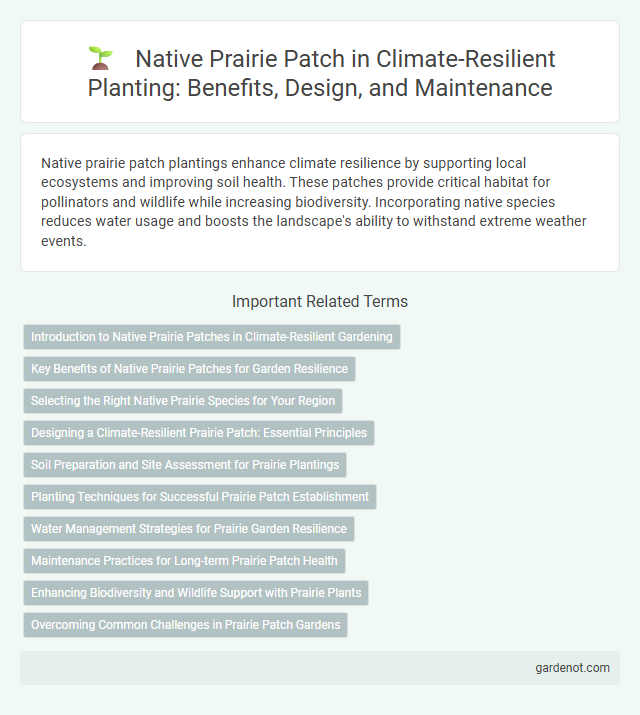Native prairie patch plantings enhance climate resilience by supporting local ecosystems and improving soil health. These patches provide critical habitat for pollinators and wildlife while increasing biodiversity. Incorporating native species reduces water usage and boosts the landscape's ability to withstand extreme weather events.
Introduction to Native Prairie Patches in Climate-Resilient Gardening
Native prairie patches serve as vital components in climate-resilient gardening by enhancing biodiversity and soil health through deep-rooted native grasses and wildflowers. These patches improve water retention, reduce erosion, and support pollinators, contributing to ecosystem stability amid changing climate conditions. Integrating native prairie patches creates sustainable habitats that adapt naturally to temperature fluctuations and variable rainfall patterns.
Key Benefits of Native Prairie Patches for Garden Resilience
Native prairie patches enhance garden resilience by improving soil health through deep-rooted native grasses that increase organic matter and water retention. These patches support biodiversity by providing habitat for pollinators and beneficial insects, reducing pest pressures naturally. Their drought tolerance and adaptability to local climate variations contribute to long-term sustainability and reduced irrigation needs.
Selecting the Right Native Prairie Species for Your Region
Selecting native prairie species that are well-adapted to your local climate and soil conditions enhances the resilience and sustainability of prairie patches. Focus on species with deep root systems such as big bluestem, switchgrass, and little bluestem to improve drought tolerance and soil health. Incorporating diverse native grasses and wildflowers promotes biodiversity, supports pollinators, and strengthens ecosystem stability amid changing climate patterns.
Designing a Climate-Resilient Prairie Patch: Essential Principles
Designing a climate-resilient prairie patch involves selecting native grasses and wildflowers adapted to regional climate variability and soil conditions, ensuring biodiversity and ecosystem stability. Key principles include maximizing plant diversity to enhance resilience against drought, extreme temperatures, and invasive species while promoting deep root systems for soil carbon sequestration and water retention. Integrating adaptive management practices such as monitoring species performance and adjusting planting compositions supports long-term functionality under changing climate scenarios.
Soil Preparation and Site Assessment for Prairie Plantings
Assessing soil composition and drainage is vital for establishing a thriving native prairie patch, ensuring plants adapt effectively to local conditions. Proper soil preparation includes removing invasive species, loosening compacted soil, and incorporating organic matter to enhance nutrient availability and moisture retention. Selecting sites with well-drained soils and minimal shading maximizes prairie plant diversity and climate resilience.
Planting Techniques for Successful Prairie Patch Establishment
Effective climate-resilient planting of native prairie patches requires selecting locally adapted seed mixes that support biodiversity and soil health. Employing no-till drilling or shallow broadcasting techniques enhances seed-to-soil contact, promoting successful germination and root development. Timing planting during early spring or late fall aligns with natural precipitation patterns, increasing establishment success under variable climate conditions.
Water Management Strategies for Prairie Garden Resilience
Native prairie patches enhance water management by promoting deep root systems that improve soil infiltration and reduce surface runoff. These root networks retain moisture and support groundwater recharge, crucial for drought resilience in prairie gardens. Integrating native grasses and wildflowers optimizes rainwater capture, minimizing erosion and sustaining plant health during variable rainfall.
Maintenance Practices for Long-term Prairie Patch Health
Native prairie patch maintenance prioritizes periodic controlled burns and strategic mowing to control invasive species and stimulate native plant growth. Soil health monitoring and adaptive management techniques, such as targeted weeding and reseeding, ensure the biodiversity and resilience of the prairie ecosystem. Consistent irrigation practices during establishment phases promote root development, supporting long-term drought resistance in prairie patches.
Enhancing Biodiversity and Wildlife Support with Prairie Plants
Native prairie patches significantly boost biodiversity by providing essential habitats for diverse wildlife species, including pollinators, birds, and small mammals. Prairie plants with deep root systems improve soil health and water retention, fostering resilience against extreme weather events linked to climate change. Establishing these patches supports ecological balance, promotes native flora proliferation, and enhances ecosystem services critical for climate adaptation.
Overcoming Common Challenges in Prairie Patch Gardens
Native prairie patch gardens face challenges such as soil compaction, invasive species encroachment, and drought stress, which can hinder plant establishment and growth. Employing deep-rooted native grasses improves soil structure and water retention, while targeted removal of invasives supports biodiversity and plant health. Integrating drought-tolerant species and adaptive management techniques ensures long-term resilience in these ecosystems.
Native prairie patch Infographic

 gardenot.com
gardenot.com